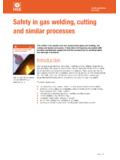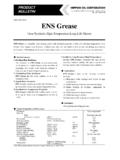Transcription of CnH2n+2 where n 16 MW: not pertinent CAS: 8012 …
1 NIOSH Manual of Analytical Methods (NMAM), Fourth Edition OIL MIST, MINERAL 5026 CnH2n+2 where n $ 16 MW: not pertinent cas : 8012-95-1 RTECS: PY8030000 METHOD: 5026, Issue 2 EVALUATION: FULLI ssue 1: 15 August 1987 Issue 2: Rev.: 15 May 1996 OSHA :5 mg/m3 NIOSH:5 mg/m3; STEL 10 mg/m3 ACGIH:5 mg/m3 (as sampled by a method which does notcollect vapor)PROPERTIES:liquid; d to g/mL @ 20 C; BP360 C; vapor pressure negligibleSYNONYMS: airborne mist of white mineral oil or the following water-insoluble petroleum-based cutting oils: cable oil; cuttingoil; drawing oil; engine oil; heat-treating oils; hydraulic oils; machine oil; transformer oil SAMPLINGMEASUREMENTSAMPLER:MEMBRANE FILTER(37-mm diameter, :m MCE, 5-:mPVC, 2-:m PTFE, or glass fiber)FLOW RATE:1 to 3 L/minVOL-MIN:20 L @ 5 mg/m3 -MAX:500 LSHIPMENT:routineSAMPLE STABILITY:stableBLANKS:2 to 10 field blanks per setTECHNIQUE:INFRARED SPECTROPHOTOMETRYANALYTE:mineral oilEXTRACTION:10 mL CCl4IR SCAN:3200 to 2700 cm-1 vs.
2 Blank CCl4 CALIBRATION:standard solutions of mineral oil in CCl4 to mg per sampleESTIMATED mg per sample [3]PRECISION ( r) [3]ACCURACYRANGE to mg/ m3 [1](100-L samples)BIAS:- [1,2]OVERALL PRECISION ( rT) [1]ACCURACY: %APPLICABILITY: The working range is 1 to 20 mg/m3 for 100-L air sample. This method is applicable to alltrichlorofluoroethane-soluble mineral oil mists, but not to (nor does OSHA s standard cover) semi-synthetic or synthetic : Any aerosol ( , tobacco smoke) which absorbs infrared radiation near 2950 cm-1 METHODS: This revises P&CAM 283 [3]. P&CAM 159 [4] and S272 [5] use similar samplers with measurement byfluorescence spectrophotometry. These methods have not been revised because of limited applicability ( , not all mineral oilscontain fluorescent components and other fluorescent compounds interfere).
3 Infrared analysis overcomes both of MIST, MINERAL: METHOD 5026, Issue 2, Rev. 15 May 1996 - Page 2 of 4 NIOSH Manual of Analytical Methods (NMAM), Fourth EditionREAGENTS: tetrachloride* (CCL4), reagent grade. mineral oil standards, 20 mg/mL. Weigh g of the bulk mineral oil sampleinto a 50-mL volumetric flask. Dilute tovolume with CCl4. Prepare in duplicate.* See SPECIAL PRECAUTIONSEQUIPMENT: : membrane filter, 37-mm, :mMCE, 5-:m PVC, 2-:m PTFE, or glass fiberfilter, with cellulose backup pad in two-piecefilter 1:High concentrations of oil mist mayplug membrane filters. Glass fibersfilters have a higher capacity for oilmist and membrane 2:Handle filters carefully with tweezersto avoid contamination by skin sampling pump, 1 to 3 L/min, withflexible connecting spectrophotometer, doulble beam,dispersive, with scanning capability in the 3200-2700 cm-1 region, and two 10-mmspectrophotometer cells, infrared quartz withPTFE stoppers mounted in demountable :Standard glass cells maybe used ifinfrared quartz cells are not , scintillation, 20-mL, with foil-lined orPTFE-lined caps.
4 * flasks, 10-, 25-, and 50-mL.* pipet or reagent dispenser, 10-mL.* , 2- to 250- * Rinse glassware with CCl4. Air PRECAUTIONS: Carbon tetrachloride is a suspected human carcinogen. Handle in a : each personal sampling pump with a representative sampler in line. at an accurately known flow rate in the range 1 to 3 L/min for a total sample size of 20 to500 :High concentrations of oil mist may plug membrane filters creating unacceptably highpressure drops. If this occurs, terminate sampling. 5 to 10 mL of unused, undiluted mineral oil in a vial. Submit with samples for MIST, MINERAL: METHOD 5026, Issue 2, Rev. 15 May 1996 - Page 3 of 4 NIOSH Manual of Analytical Methods (NMAM), Fourth EditionSAMPLE PREPARATION: tweezers, transfer each sample or blank filter to a vial. Add mL CCl4. Cap and AND QUALITY CONTROL: daily with at least six working known amounts of stock mineral oil standard to CCl4 in 10-mL volumetric flasks and diluteto the mark to obtain mineral oil concentrations in the range 5 to 250 with samples and blanks (step 8).
5 Calibration graph (peak absorbance vs. :g mineral oil). recovery (R) at least once for each lot of filters used for sampling in the range ofinterest. Prepare three filters at each of five levels plus three media a known amount of stock mineral oil standard onto the filter. Allow solvent samples overnight in filter and analyze with working a graph of R vs. g mineral oil recovered. three quality control blind spikes and three analyst spikes to ensure that the calibrationgraph and R graph are in : each standard solution and each blank or sample filter extract from 3200 to 2700 cm-1 inabsorbance mode vs. CCl4 in reference beam. Record absorbance at wavelength of largestabsorbance near 2940 cm-1 ( ).CALCULATIONS: the mass, g (corrected for R), of mineral oil found in the sample (W) and in theaverage media blank (B) from the calibration concentration, C, of mineral oil in the air volume sampled, V (L)EVALUATION OF METHOD:The sampling portion of this method was evaluated over the range to mg/m3 at 22 C and 755 mmHg using 100-L air samples of Gulf machine cutting oil with measurement by fluorescence cellulose ester filters, m pore size, were used for sampling [1,5].
6 The overall precision was an average recovery of 98%. The infrared measurement method was subsequently evaluated by NIOSH[2,3]. Precision and accuracy of the infrared and fluorescence spectrophotometric techniques are MIST, MINERAL: METHOD 5026, Issue 2, Rev. 15 May 1996 - Page 4 of 4 NIOSH Manual of Analytical Methods (NMAM), Fourth EditionIssue 1 of this method (dated 8/15/1987) used Freon 113 as the solvent. However, since Freons are knownatmospheric ozone depleters, carbon tetrachloride, the original solvent used in P&CAM 283, is again specified,although it is a suspected human carcinogen. PTFE filters ( Gelman Zefluor) also may be used to sample oil mists. They have lower blanks than PVC,since PTFE has fewer extractables with CCl4 than other membrane :[1]Documentation of the NIOSH Validation Tests, S272, Department of Health, Education, andWelfare, Publ.
7 (NIOSH) 77-185 (1977), available as PB 274-248 from NTIS, Springfield, VA 22161.[2]Bolyard, M L. Infrared Quantitation of Mineral Oil Mist in Personal Air Samples, AIH Conference,Houston, TX (1980).[3]NIOSH Manual of Analytical Methods, 2nd ed., Vol. 4, P&CAM 283, Department of Health,Education, and Welfare, Publ. (NIOSH) 78-175 (1978).[4]Ibid., Vol. 1, P&CAM 159, Department of Health, Education, and Welfare, Publ. (NIOSH)77-157-A (1977).[5]Ibid., Vol. 3, S272, Department of Health, Education, and Welfare, Publ. (NIOSH) 77-157-C(1977).METHOD REVISED BY:Charles Lorberau and Robert Glaser, NIOSH/DPSE.















